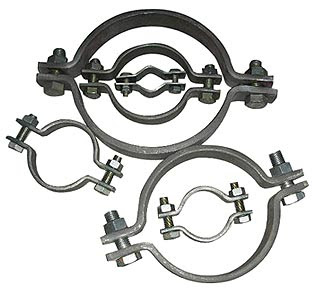Archive for June, 2010
Threaded Rods
by Hi-Tech on Jun.10, 2010, under Fasteners
Buying TipsFactors to consider are:
|
- Stainless steel
- Carbon steel
- Alloy steel
- Aluminum
- Brass
- Copper
- Bronze etc.
- Threaded rods are resistant to chemicals.
- These rods are electrically insulating.
- They are non-magnetic.
- They are lightweight.
- They have low thermal conductivity.
- They reduce vibration and abrasion.
Pipe Clamps
by Hi-Tech on Jun.10, 2010, under Clamps, Pipe Fasteners

Buying Tips
Pipe clamps can be ordered as complete arrangements or separate components. Certain factors to consider to buy pipe clamps are as follows:
- Type of clamp
- Size
- Material
- Finish
- Durability
- Mechanical Properties
- Tensile Strength
- Flexural Yield Strength
- Impact Strength
- Tensile Test
- Thickness
- Modules of Elasticity
- Thermal Properties
- Continuous Service
- Temperature Range
- Electrical Properties
- Volume Resistivity
- Chemical Properties
Pipe clamps usually have one fixed pad, and one adjustable pad. Pipe clamps are constructed using various materials and are available in several configurations with a variety of finishes. Metallic pipe clamps have high impact resistance and various finishes like a brilliant, glossy finish, heat-resistant coatings and epoxy coatings or plain look or hot-dip galvanized or painted.
- Carbon steel
- Mild steel
- Stainless steel
- Alloy steel
- Titanium
- Aluminum
- Thermoplastic elastomer
- Polypropylene
- Polyamide
- PVC etc.
- Rigid Clamps
- U-Bolt Clamps
- Flat Cushion Clamps
- Oval Clamps
- U-Bolt with Cushion Clamps
- P Style Clamps
- Swivel Bolt Clamps
- Diameter
- Outside diameter of pipe
- Cap nut diameter
- Load ability
- Simple to operate
- Easy to install
- Adjustable in small range
- Good appearance
- Temperature range is dependent on the clamp lining being used.
- All pipe clamps are designed to have a very high impact resistance.
- Make for quick, easy pipe installation and layout.
- Shock-absorption
- Vibration dampening
- Noise reducing property
- Heavy torque
- Usually used for large diameter pipes etc.
- The clamp should be mounted directly after the threaded connection or coupling of the piping which in turn protects the connection from vibrations.
- Bends in the line should be clamped on both sides of the pipe bend.
- The pipe line should be clamped directly before and after any in-line valves.
- Proper Torquing of the clamp bolts is very essential.
- Used for fastening and fixing various pipelines whether in construction or industries or buildings etc.
- Provide fast, safe, economic service and installation in piping system.
- Pipe clamps are designed for a wide range of fastening applications.
- These clamps are ideal for suspension of cold or hot pipe lines with heavy load having little or no insulation.
- They are also used for high and even tightening force around the pipe, minimizes leakage.
- The pipe clamps absorb shock, dampen vibration, and reduce noise in plumbing systems.
- They can be used in high temperature applications.
Eye Bolts
by Hi-Tech on Jun.10, 2010, under Eye Bolts, Fasteners
Buying tips
Certain specifications to consider before buying eye bolts are as follows:
- Maximum load capacity: The maximum load which an eyebolt can handle.
- Shank length: Shank length equals the thread length, for fully-threaded eyebolts.
- Threaded length: Thread lengths for eyebolts are measured in English units like in inches (in) or metric units such as millimeters (mm).
- Eye inside diameter (ID)
- Eye thickness or Eye section diameter
- Total weight
- Material
- Copper
- Cast Iron
- Aluminum
- Brass
- Bronze
- Stainless steel
- Alloy
- Titanium
- Plastic
- Rubber etc.
- Forged eyebolts: These eyebolts are forged instead of formed. They are one-piece fasteners offering higher load ratings.
- Shoulder eyebolts: These eyebolts have a shoulder under the eye and the shoulder is installed flush with the mounting surface.
- Thimble eyebolts: These eyebolts are designed with an opening that acts as a thimble for rope or wire to minimize wear.
- Pivoting eyebolts: These eyebolts are designed in such a way to pivot 180°.





